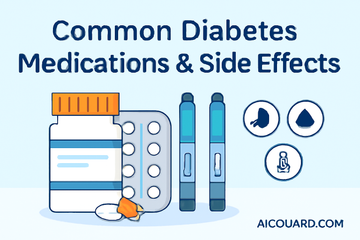Common Medications for Diabetes and Their Side Effects

Diabetes is a chronic condition that affects millions worldwide, and managing it often requires a combination of lifestyle changes and medication. While medication can help control blood sugar levels and prevent complications, it’s essential to understand the common drugs prescribed for diabetes and their potential side effects. This knowledge helps patients make informed decisions and communicate effectively with their healthcare providers.
1. Metformin
Overview:
Metformin is usually the first medication prescribed for type 2 diabetes. It works by reducing glucose production in the liver and improving insulin sensitivity, helping the body use glucose more effectively.
Common Side Effects:
-
Gastrointestinal issues such as nausea, diarrhea, and stomach cramps
-
Metallic taste in the mouth
-
Rarely, a serious condition called lactic acidosis (a buildup of lactic acid in the blood)
Tips:
Taking metformin with meals can help minimize stomach upset. Always report unusual symptoms like muscle pain, weakness, or breathing difficulties to your doctor immediately.
2. Sulfonylureas (e.g., Glipizide, Glyburide)
Overview:
Sulfonylureas increase insulin secretion from the pancreas, lowering blood sugar levels.
Common Side Effects:
-
Low blood sugar (hypoglycemia), especially if meals are skipped
-
Weight gain
-
Allergic skin reactions (rare)
Tips:
Monitor blood sugar levels regularly to avoid hypoglycemia and eat meals on time when using these medications.
3. DPP-4 Inhibitors (e.g., Sitagliptin, Saxagliptin)
Overview:
DPP-4 inhibitors help increase insulin production only when blood sugar is high and reduce the amount of glucose produced by the liver.
Common Side Effects:
-
Upper respiratory tract infections
-
Headache
-
Joint pain
-
Rare cases of pancreatitis
Tips:
Report any severe abdominal pain or persistent joint pain to your healthcare provider promptly.
4. GLP-1 Receptor Agonists (e.g., Liraglutide, Exenatide)
Overview:
These injectable medications mimic the incretin hormone, which increases insulin release, decreases glucagon production, and slows digestion.
Common Side Effects:
-
Nausea and vomiting
-
Diarrhea
-
Possible weight loss (often considered a beneficial side effect)
-
Risk of pancreatitis (rare)
Tips:
Start with a low dose and gradually increase as prescribed to reduce gastrointestinal discomfort.
5. SGLT2 Inhibitors (e.g., Canagliflozin, Empagliflozin)
Overview:
SGLT2 inhibitors help the kidneys remove glucose through urine, lowering blood sugar levels.
Common Side Effects:
-
Urinary tract infections
-
Genital yeast infections
-
Increased urination
-
Dehydration and low blood pressure
Tips:
Maintain good hygiene and stay hydrated to reduce the risk of infections and dehydration.
6. Insulin Therapy
Overview:
Insulin is essential for type 1 diabetes and sometimes prescribed for type 2 diabetes when other medications are insufficient.
Common Side Effects:
-
Hypoglycemia
-
Weight gain
-
Injection site reactions
Tips:
Proper injection techniques and regular blood sugar monitoring are crucial to avoid hypoglycemia.
Final Thoughts
While diabetes medications are vital for controlling blood sugar and preventing complications, they can have side effects that require attention. Always communicate openly with your healthcare provider about any new or worsening symptoms. Remember, lifestyle changes like a balanced diet, regular exercise, and weight management play an equally important role alongside medication in managing diabetes effectively.





